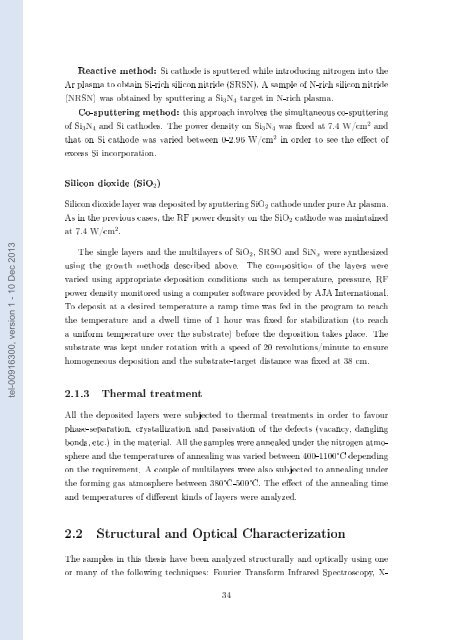Films minces à base de Si nanostructuré pour des cellules ...
Films minces à base de Si nanostructuré pour des cellules ...
Films minces à base de Si nanostructuré pour des cellules ...
Create successful ePaper yourself
Turn your PDF publications into a flip-book with our unique Google optimized e-Paper software.
Reactive method: <strong>Si</strong> catho<strong>de</strong> is sputtered while introducing nitrogen into the<br />
Ar plasma to obtain <strong>Si</strong>-rich silicon nitri<strong>de</strong> (SRSN). A sample of N-rich silicon nitri<strong>de</strong><br />
(NRSN) was obtained by sputtering a <strong>Si</strong> 3 N 4 target in N-rich plasma.<br />
Co-sputtering method: this approach involves the simultaneous co-sputtering<br />
of <strong>Si</strong> 3 N 4 and <strong>Si</strong> catho<strong>de</strong>s. The power <strong>de</strong>nsity on <strong>Si</strong> 3 N 4 was xed at 7.4 W/cm 2 and<br />
that on <strong>Si</strong> catho<strong>de</strong> was varied between 0-2.96 W/cm 2 in or<strong>de</strong>r to see the eect of<br />
excess <strong>Si</strong> incorporation.<br />
<strong>Si</strong>licon dioxi<strong>de</strong> (<strong>Si</strong>O 2 )<br />
<strong>Si</strong>licon dioxi<strong>de</strong> layer was <strong>de</strong>posited by sputtering <strong>Si</strong>O 2 catho<strong>de</strong> un<strong>de</strong>r pure Ar plasma.<br />
As in the previous cases, the RF power <strong>de</strong>nsity on the <strong>Si</strong>O 2 catho<strong>de</strong> was maintained<br />
at 7.4 W/cm 2 .<br />
tel-00916300, version 1 - 10 Dec 2013<br />
The single layers and the multilayers of <strong>Si</strong>O 2 , SRSO and <strong>Si</strong>N x were synthesized<br />
using the growth methods <strong>de</strong>scribed above. The composition of the layers were<br />
varied using appropriate <strong>de</strong>position conditions such as temperature, pressure, RF<br />
power <strong>de</strong>nsity monitored using a computer software provi<strong>de</strong>d by AJA International.<br />
To <strong>de</strong>posit at a <strong>de</strong>sired temperature a ramp time was fed in the program to reach<br />
the temperature and a dwell time of 1 hour was xed for stabilization (to reach<br />
a uniform temperature over the substrate) before the <strong>de</strong>position takes place. The<br />
substrate was kept un<strong>de</strong>r rotation with a speed of 20 revolutions/minute to ensure<br />
homogeneous <strong>de</strong>position and the substrate-target distance was xed at 38 cm.<br />
2.1.3 Thermal treatment<br />
All the <strong>de</strong>posited layers were subjected to thermal treatments in or<strong>de</strong>r to favour<br />
phase-separation, crystallization and passivation of the <strong>de</strong>fects (vacancy, dangling<br />
bonds, etc.) in the material. All the samples were annealed un<strong>de</strong>r the nitrogen atmosphere<br />
and the temperatures of annealing was varied between 400-1100 °C <strong>de</strong>pending<br />
on the requirement. A couple of multilayers were also subjected to annealing un<strong>de</strong>r<br />
the forming gas atmosphere between 380°C-500°C. The eect of the annealing time<br />
and temperatures of dierent kinds of layers were analyzed.<br />
2.2 Structural and Optical Characterization<br />
The samples in this thesis have been analyzed structurally and optically using one<br />
or many of the following techniques: Fourier Transform Infrared Spectroscopy, X-<br />
34
















